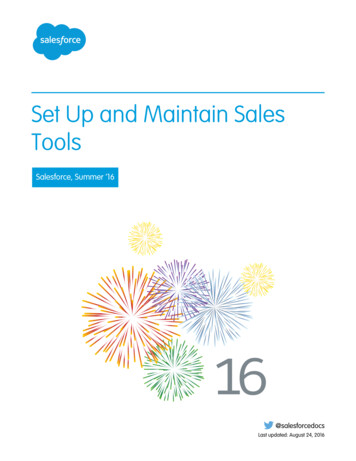
Transcription
Social Intelligence Guide for Sales
Deliver amazing customer experiences.Glengarry Glen Ross is an amazing film, and I had a lot of fun with one of my favoriteteams riffing on the famous Alec Baldwin scene as inspiration for naming this ebook.That being said, a lot has changed in sales since the fictitious burglary of the leads inthat Chicago real estate office.In my career at Disney, Oracle and now Microsoft, I’ve seen the amazing impacttechnology has on real business. In the dot-com boom, we focused on usingtechnology to drive down costs, extend reach, and grow businesses. We were verysuccessful, but ended up with businesses that were transactional. Today, social is anew part of our lives, something that puts a human element back into business in away that scales beyond face-to-face interactions. Sales teams have an unprecedentedopportunity to reach more would-be customers than ever, and the way we sell willnever be the same.This first ebook on social listening for sales also accompanies the launch of MicrosoftSocial Listening and Social Insights, powered by InsideView. Both are now available inDynamics CRM at no additional cost and can be used by anyone with a professionallicense*. This type of affordable, democratized social insights is set to change thegame for our customers, and we’ve only just begun.We hope you find this series valuable to your organization, and we look forward tohearing about how you deliver amazing customer experiences.All my best,Fred StuderGM, Microsoft Dynamics CRMhttps://twitter.com/fredstuder*Social Insights, powered by InsideView is currently only available in the US.2
TABLE OF CONTENTSpage 4Social Selling Using Online Networks to Build Relationshipsand Boost Sales5Social Sales Quickstart6Using Social Listening to Drive Sales Leads7Nurturing Leads with Social Insights8Building Lasting Social Media Relationships9Insights from the Experts
Social SellingUSING ONLINE NETWORKSTO BUILD RELATIONSHIPSAND BOOST SALESCustomers want to be treated like individuals, notpsychographic profiles. The more connected you are totoday’s social and mobile customer, the better chance youhave of establishing trust and having an honest dialogue.Social doesn’t replace email. Cold calls aren’t dead. Thesetactics all have their time and place, but social represents themost exciting channel that sales has had in a long time to stayconnected and informed.Successful social selling hinges on authentically connectingwith customers on social networks, building trustedrelationships with them, and ultimately helping them solveproblems that lead to lasting business relationships.If you aren’t tapping into socialselling, you’re missing out. In 2012, salespeople using social media to sell outperformed those whoweren’t using social media 78.6% of the time.1 What’s more,social sales people were 23% more successful at exceedingtheir quotas than their non-social sales peers. Social salespeople are doing all this by spending just 10% of their timeon social channels. Surprisingly, however, more than half ofthe sales organizations surveyed by the Sales ManagementAssociation believe their current social efforts are not sufficient:55% say they would be more productive if they had a largersocial presence.Imagine the possibilities of throwing a formal social strategyinto the sales mix. Social helps you find prospects as they areactively searching for products or looking for solutions yourcompany can offer. Social enables you to extend what makesgreat sales people—connecting with customers, listening, andbuilding relationships. It doesn’t replace anything, but ratherscales your ability to connect authentically with your prospects.Use the invaluable context and second-degree connections toreach prospects at their point of need and through a trusted,mutual connection.The most effective sales teams make it easy for their executivesand account managers to make sense of social data. In thefollowing pages, you’ll discover how to use social to drive salesleads, move those leads through the sales funnel, and buildlasting social relationships.1A Sales Guy Consulting: /docs/social media sales quota.pdf4
Social SalesQUICKSTARTToday’s customers make purchases the way they choose,researching online before walking into a store or talking to asales representative. CEB analysts found that customers are57% through the typical decision-making process before theyever engage with a sales rep 1. SiriusDecisions also reports thatcustomers are 70% through the buying process in a complexsales situation 2.That means if your sales team is not online, your prospects willnot be able to find you during these critical research stages.Creating complete social profiles with education and workexperience is just the first step to meeting your customers theway they prefer. The best social salespeople build out theironline presence by connecting to their customers (who canprovide references), listening to influencers in their industry,and sharing updates that showcase their expertise in their field. 1: hallenger/new-decision-timeline/index.page2: g Organization 20175
Using Social ListeningTO DRIVE SALES LEADSSalespeople know that their book of business is built onpersonalized interactions. Social offers the ability to scale theseinteractions, leading to greater productivity, and ultimately,sales. This ability comes with expectations; customers arenow accustomed to reps that follow their activity—and onlyreach out when the time is right and with the right message.Successful social salespeople don’t broadcast genericmarketing messages or post overt product pitches. In fact,both those ingredients are part of a recipe for irrelevance thatcan annoy would-be customers and shrink followings.2. Monitor your competition: ListeningIn today’s over-subscribed, under-resourced world, it’s notpossible to be high-touch with everyone all the time, sothe smart salesperson has learned to be low-touch until theopportunity arises to be high touch. Social listening can helpyou identify true leads and allow you to offer your solution ina conversational context. With that in mind, here are 3 ways touse social listening to identify sales leads:3. Get personal: OK, not too personal. Simply1. Empower your sales team withsocial insights: Today, some of the more advancedsales teams have set up social listening software to monitorkeywords that suggest customers are actively searching for aproduct recommendation. They adapt their typical discoveryquestions to key phrases people may be searching for in theirindustry, and then route these leads to the right salesperson.Another best practice is to provide social insights at the lead,contact, and account level within your CRM system. MicrosoftDynamics, for example, provides all sales professionals withaccess to social insights on leads, contacts, and accounts at noadditional cost and can be used by anyone with a professionallicense*.*Social Insights, powered by InsideView is currently only available in the US.to what customers are saying about your brand can openthe door to offering relevant solutions, but listening to whatpeople are saying about your competitors can showcaseweak spots in their offering. Think of it as an opportunity tohelp, and have the appropriate salesperson send the customersomething useful. Are people dissatisfied with a competitor’sproduct? Can your product pick up the slack? Monitoring thecompetition can help you deposition them and drive moreleads for your team.pitching your products into the social media realm is likespeaking to an empty room. On social, people expect toreceive personalized messages. Have your sales team engagein conversations with prospects on social networks. Whenthey post about those new watch styles on Facebook, haveinformation on industry trends ready for your team torespond with to subtly throw your brand into the mix. With acoordinated effort from your sales team, you can start to worktowards answering every post by your top target accounts.6
Nurturing LeadsWITH SOCIAL INSIGHTSDo your homework.Mastering the use of LinkedIn, Twitter, and Facebook asresearch tools allows reps to speak credibly to a prospect’sjob, industry, family, and interests—giving reps invaluablecontext for conversation before they ever pick up the phoneor compose an email. One of the easiest ways to reduce thesocial “noise” is to integrate real-time social data into yourCRM. When you can associate social data to a specific accountor lead record, you enable your sales team to have moreproductive conversations.Doing your homework also means staying on the lookout forpotential referrals or introductions, something social networkshelp to streamline.Showcase your expertise to staytop-of-mind.The best salespeople understand that regularly sharingvaluable tools and insights about their products, industryupdates, and personal updates can help them stay top-ofmind with their customers, as well as build rapport and conveypositive character.Salespeople who are just starting out on social can lean ontheir marketing department for high-quality content to post,while salespeople who are more savvy on social can addmarketing’s content to their existing social posts.The biggest risk of social selling is not doing anything. Don’tbe afraid to engage. Now that you’re following leads andcollecting social intel in your CRM records, spend a fewminutes each day to read the content a someone has posted—and pass it on if you learned something valuable.More importantly, you need to have incredible content thatactually teaches someone something new or helps them dotheir jobs better. Partnering with marketing to provide this typeof content can boost your sales team’s relevancy and positionyour salespeople as thought leaders.Buyers today are not satisfied with a one-dimensional salespitch. They are looking for trusted experts who can enablethem to make a purchase decision with multifaceted researchand resources. If your sellers are not building relationships toposition themselves as advisors, your competition could swoopin and earn new customers by filling this gap.7
Building LastingSOCIAL MEDIA RELATIONSHIPSToday’s social networks are built on authentic, personalrelationships between people, so it makes sense that overtpitches or ads don’t do well with customers on social. The bestsocial sales reps keep that in mind and show their human sideon social. This enables them to build trust and rapport withtheir customers, so that when a risky business decision arises,they will want to do business with them.The best sales leaders are plugged into the social activityof their top accounts. By following your contacts on socialchannels, you’ll be able to develop a rapport, as well asrespond to any issues or challenges they encounter.Every good relationship starts with conversation—and it’snot just about you talking up a social media storm. The bestrelationships involve listening and responding. And like anyrelationship, you get out what you put into it.1. Connect with your customersand prospects on the appropriatechannel: Although Facebook and Twitter are themost popular social networks, LinkedIn is the best optionfor business-to-business sales. Also, don’t neglect blogs andforums as well. Many sales operations leaders now leveragesocial listening technology to discover the primary digitalcommunities of their target audience and lead a focused effortto establish a helpful, consultative presence in those areas.2. Partner with customer service:Sometimes, a salesperson will find a dissatisfied customer witha problem that is too complex to address on his or her own.No one expects sales to become service professionals, butworking with your service team to create open channels ofcommunication can help get that customer the answers andhelp they need in record time. You should also actively publishexamples of the amazing customer experiences your serviceteam creates.3. Mix it up: Scatter your posts over different times ofthe day. You’ll reach more of your audience by spreading yourcontent across different time zones. When should you post?There’s plenty of research out there and some of it is conflicting.The best answer is to do your own tests. Discover when youget the best traction. You may find some clues from youre-mail marketing campaigns. Some companies no longer sendemails early in the morning on a weekday because everyone’sinbox is flooded. Find what works for your followers—andkeep iterating.TIP: Following your leads on LinkedInand Twitter can open the door to newopportunities. Simply posting HappyBirthday, or congratulating someoneon a new position can go a long way tobuilding and maintaining relationships.8
InsightsFROM THE EXPERTSWe published these responses from some of theworld’s most influential social thought leaders, raw andunfiltered. While the views expressed here may notnecessarily reflect the views of Microsoft or endorseMicrosoft’s products, we are all about diversity ofopinion and open dialogue. We believe this is the bestway we can support our customers.As we continue to build on this series to discover howcompanies are creating amazing customer experienceson social, we’d love to hear from you.Who should we reach out to?How should we look at this differently?Let us know at @MSFTDynamics.Regards,The Microsoft Dynamics CRM Team9
InsightsFROM THE EXPERTSCLARA SHIHCEO & Founder Hearsay Social, board member of Starbucks, author of The Facebook Era@clarashihWhat are three key elements of aneffective social strategy?What are your top 3 tips on how toget up to speed on social? Focus on customer rather than on functional silos Clear business goals and metrics Executive sponsorshipHow has engaging your customerson social benefited your companyor your clients?1) Use social like a consumer first to learn the etiquette, lingo,and customer perspective, and only then start using it forbusiness.2) See how the best companies do it and adapt the best ideasfor your business (e.g, Starbucks, AXA, Lululemon).3) Start small and keep iterating. Social media is a long-termcommitment, not a one-off campaign. Don’t be afraid offailure or not getting it exactly right the first time around. Product ideas and feedback Word of mouth Close connection with the customer voice and stories whichare incredibly compelling to all of our employeesHow important is social listening toyour marketing team or marketingteams in general?What are some tips on dealing withnegative sentiment on social?Extremely important to listen first before responding or takingother action.Be honest and responsive. Diffuse and move the conversationoffline if possible. View it as an opportunity to get even better.Who are the top 5 people youfollow on social? Aaron Levie: @levieJeff Weiner: @jeffweinerBill Murray: @billmurray (parody account)Linda Descano: http://www.linkedin.com/influencer/204274949 Mohamed El-Erian: http://www.linkedin.com/today/influencer?authorId 34334392How important is social listeningto your sales team or sales teams ingeneral?Extremely important. Sales is the next frontier of social business. At Hearsay Social, we started our entire company on thispremise and have seen record growth year after year since wefounded the company in early 2010.How important is social listeningto your customer service team orteams in general?Very important. Depends on the industry you are in andwhether your customers want to be serviced through socialmedia channels.10
InsightsFROM THE EXPERTSBRIAN SOLISPrincipal Analyst at Altimeter Group and author of What’s the Future of Business (WTF)@briansolisWhat are three key elements of an effective social strategy?In a recent Altimeter Group report published by Charlene Liand me, we found that only 17% of companies identify theirsocial strategy as mature. Just 60% feel their social strategy isconnected to actual business goals.After all of these years, the evolution of social media is not asfar along as many would like to believe.1) In our research, we also learned that just over one-thirdof businesses look at metrics beyond likes, followers,and comments to measure the impact on the companybottom line. This means that most businesses are lookingat tactical numbers and not the bigger picture. Theseengagement metrics only represent activity and notnecessarily movement toward something more meaningfulor important.An effective social strategy starts with defining what it isyour social strategy is designed to do. Believe it or not,this is something that most businesses miss. Aligning socialmedia strategies with business goals from the onset helpsorganizations begin a meaningful journey toward becominga social business.– What will you improve?– What is your mission?– How will you add value?– How would your customers confirm that your socialstrategy is brilliant?– What would they say?This is your North Star.3) A true social strategy also looks beyond marketing.Yet today, most social media strategies are run by themarketing team, which creates a silo. While marketingis important, an effective social strategy considers thecustomer lifecycle. A mere 28% of businesses we studiedfelt that they had a holistic approach to social media, wherelines of business and business functions operate in a unifiedand complementary fashion.Consider how marketing, service, HR, and lines of businesscan work together to meet the needs and expectations ofprospects and customers. The only way to break down silosis to work together.2) Your social media strategy must set out to do somethingmeaningful. Unfortunately, organizations jump into socialwithout thinking of the greater benefits for the brandand for customers and employees. Everything startswith defining a vision and purpose for your social mediastrategy. It must articulate what customer relationships andexperiences will look like.11
InsightsFROM THE EXPERTSMORGAN NORMANVP of Revenue Generation Zuora@meetmorgWhat are three key elements of aneffective social strategy?What are your top 3 tips on how toget up to speed on social? Enable your whole company, and send the right story to theright people. You have to listen to where your customers are andunderstand your presence. You can use social listening as abenchmark. Many people have a fragmented social strategy, and thesocial presence often doesn’t match the brand presence. It’simportant to match that voice. Like all things you just have to do it. You have to getdirty. If you are in sales you need to follow your industry,competitors, brands. Identify your industry influencers.Know who the top leaders in companies are. Follow themon LinkedIn, Twitter, Facebook. Get connected to marketing.Leverage the content that marketing provides to offerconsultative material that actually helps people do their jobs.How has engaging your customerson social benefited your companyor your clients?Social helps us reach people outside of our database, forexample, people that are experiencing a problem that wehaven’t thought about yet. Social has helped us become moreof an agile organization, and we can evolve our story and ourmessaging quickly. Social also lets you build on PR. In the pastit would just die off, but social lets you keep a story alive over alonger period. Social is also one of the greatest ways to launchproducts. It allows people to offer a lot of promos, and you cantest various mechanisms and see how people respond in realtime.What are some tips on dealing withnegative sentiment on social? The most important thing is to be responsive. You can’tignore it. You have to first understand what you’ve done tonot meet someone’s needs, and you need to act fast. The other thing is that people are not trained in customerservice. They don’t know how to immediately give someonethe right answer. People are not only tweeting a company,they are tweeting the CEO. You need to empower everyoneto respond. Social enterprise solutions, such as Yammer,can really help with this. You should also build a follow-upprocess to learn.Who are the top 5 people youfollow on social?I spend my time following new brands. This helps meunderstand their social approach. I’m more curious aboutbrands then people. Hipmunk. Hubspot. Marketo. Mailchimp.I’m looking for techniques. You know, it’s one thing for peopleto connect with people, but how to companies connect withtheir customers in meaningful ways. For marketers, you should really think about how youempower your entire company to distribute your content.Create an integrated, cross-department approach. Thisebook is about social listening and this is the first thingyou need to do. Understand what matters to your targetaudience and create content around that, not what youthink they want, but what they are actually asking about.Break out of Twitter and LinkedIn. Look at Slideshare, socialwebinars. Don’t be shy about reaching out to other peopleto learn. Take twenty minutes with someone that you respectand see what they are doing. You have to record social ROI.Your landing pages need to tag leads accordingly, so youcan make data driven decisions about where to spend yourtime. A lot of people miss the analytics of social, and this is amistake. You should be all over it. Design matters in social. Don’t be cheap. Designers are thenew engineers in Silicon Valley. Create digestible content.How important is social listening toyour marketing team?Extremely. This depends on your brand. Are you B2B? B2C? Ofcourse it’s very important, but it’s different for all companies.How important is social listening toyour sales team?Very important. While we are interested in social, our accountexecutives are busy. From a demand gen perspective, it’sextremely important. From a sales perspective, it’s veryimportant when you have time.How important is social listening toyour service team?It’s hard to rate it in this way. Of course it’s important. ForZuora, our service comes through other channels. In theperspective of empowering buyers is extremely important, butit’s not the main way that people reach out to us.12
InsightsFROM THE EXPERTSMICHAEL BRITOGroup Director, Content & Engagement The W2O Group@britopianWhat are three key elements of aneffective social strategy?Who are the top 5 people youfollow on social?I would say that the three elements of a social strategy consistof analytics, content and engagement. Analytics will give youa 360-degree view of your customer and what they truly careabout. In addition, looking at historical content performanceis key to better understanding how and when they like toconsume content. These variables will help deliver a moreeffective brand story (content) that will break through theclutter and reach consumers with game-changing content.The last is engagement. What’s the point of creating awesomecontent if you aren’t going to prove that the brand is humanand engage in a conversation. How has engaging your customerson social benefited your companyor your clients?Engagement equals brand love. When brands prove thatthey are human, solve customer problems and/or providehelpful information, they naturally create brand advocates. Anadvocate is someone who will promote or defend the brandwithout being asked to do so. This is good for all brands.What are some tips on dealing withnegative sentiment on social?The first tip is to ensure that the sentiment data is actuallyaccurate. Sentiment analysis still has a long way to go beforeit can be substantiated as a good measurement framework.That said, the second tip is to “only” engage in negativeconversations if you are actually planning on having aresolution. If you aren’t prepared to manage negativity, then Iwould say that social media may not be the right channel foryou to engage in quite yet.Jeremiah Owyang: @jowyangJacob Morgan: @jacobmDave Berkowitz: @dberkowitzBrian Solis: @briansolisJay Baer: @jaybaerWhat are your top 3 tips on how toget up to speed on social?1) Just do it. Stop procrastinating. You will make mistakesand learn from them.2) Read a lot. There are several blog posts and resourcesfor you.3) Participate: Use the tools personally so you can learnhow to apply them professionally.How important is social listening toyour marketing team or marketingteams in general?Extremely. Just like any relationship, the majority of what youshould be doing is listening.How important is social listeningto your sales team or sales teams ingeneral?Extremely. For the same reasons above.How important is social listeningto your customer service team orteams in general?Extremely.13
InsightsFROM THE EXPERTSJESSICA SMITHSenior Marketing Director FlexJobs.com@JessicaNowWhat are three key elements of aneffective social strategy? Defining what success looks like and being able to clearlyarticulate it to the organization. Setting a baseline and then mapping metrics to that successso the team can pivot and optimize appropriately. Developing tactics to support and then testing, measuring,and tweaking those tactics to reach established goals andbenchmarks.How has engaging your customerson social benefited your companyor your clients?A job search can be very personal for a lot of people so weidentify their pain points and address them through a robustcontent strategy that aims to be helpful but still respectsthat this is a personal experience for them. By measuringengagement, we have also realized that jobseekers liketo hear first-hand experiences of other jobseekers so weregularly featured job seeker success stories. These get a lotof great responses across our social channels. The benefits ofhaving strong content and different voices represented is thatour content is shared across various social channels. Unlikeother job boards, our paying customer is the jobseeker versusthe employers, so our conversations and content are based onwhat they, the jobseekers, want and what they have expressedthat they need.What are some tips on dealing withnegative sentiment on social?There are varying degrees of negative sentiment thatcompanies will deal with on social. For example, a customercomplaint that is easily and quickly resolved is a lot differentthan a crisis situation where the impact to business is large andhard to contain. Here are 5 things I recommend when facedwith negative sentiment on social. Even if you don’t have an immediate answer or solution,acknowledge the frustration/anger/disappointmentimmediately so that the person (or people) know they havebeen heard and that it’s being addressed. Do this publiclyon the social channel where the negative sentiment wasinitiated. Next step is to have them privately send you their preferredmethod of direct contact information such as a phonenumber or email so that you can take the conversationoffline. You will accomplish more one on one. With that said, remember that anything you say throughprivate channels can easily be relayed via social. Beespecially careful with what you send via email asscreenshots can be taken and shared within minutes. Make sure every communication you have demonstratesyour commitment to resolution. If the person or people insist on continuing the conversationvia the social channel versus one-on-one, don’t panic. Usethis as an opportunity to show the public how well yourorganization handles their customer experience and howresponsive you are via social. Sometimes you will run into people who do not want toresolve the issue and really just want to drag your namethrough the mud. This is unfortunate but not unusual. Takethe high road, offer reasonable solutions, and be clear andconcise in your communication. If you remain reasonableand fair, you will find that you will come out more respectedby your existing fans and might pick up a few new onesbecause of your professionalism.Who are the top 5 people youfollow on social? John Andrews: www.linkedin.com/in/katadhin David Meerman Scott: www.linkedin.com/in/davidmeermanscott Maggie McGary: www.linkedin.com/in/maggiemcgary Amy Vernon: www.linkedin.com/in/amyvernon Don Bartholomew: www.linkedin.com/in/donbartholomewWhat are your top 3 tips on how toget up to speed on social? Don’t overthink it. Just remember it’s two-waycommunication, so don’t use it like a bullhorn. Think about your personal favorite brands, and see how theyare using social. Be active on LinkedIn; there are lots of really goodinfluencers sharing their expertise.14
InsightsFROM THE EXPERTSRYAN HOLMESCEO, HootSuite@invokerWhat are three key elements of aneffective social strategy? Planning and goal-setting. What goals are you tryingto achieve as an organization? Who are your customers,and what is most important to them? What level ofsocial empowerment are you looking to achieve—team,department, or organization-wide? Are you in a regulatedindustry, such as healthcare or financial services, where thereare communication restrictions?Consider how social media can help your companyachieve its most important objectives and then set somegoals. Next, identify the resources necessary to manageyour social media efforts, set guidelines for how employeesshould engage in social media, and provide training toencourage active participation that is aligned with companygoals. Active listening and engagement. Start by monitoringfor mentions—the good, the bad and the ugly—of yourbrand. Also listen for cues and trends in your industry andon your competitors. Next, follow the conversations andthe people that are relevant to your business. Then beginto engage in conversations with content that is interesting,relevant or useful to your audience. Retweet posts you findinteresting and use hashtags to increase the discoverabilityof your content. Measure results. Provide visibility on how your socialprograms are moving the needle. If you are just kick-startingyour soci
2. Partner with customer service: Sometimes, a salesperson will find a dissatisfied customer with a problem that is too complex to address on his or her own. No one expects sales to become service professionals, but working with your service team to create open channels of communication can help get that customer the answers and











